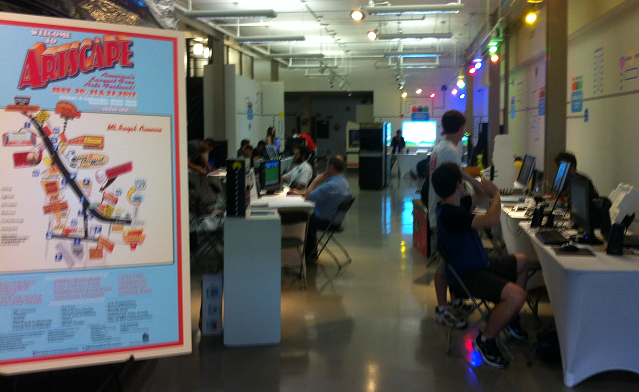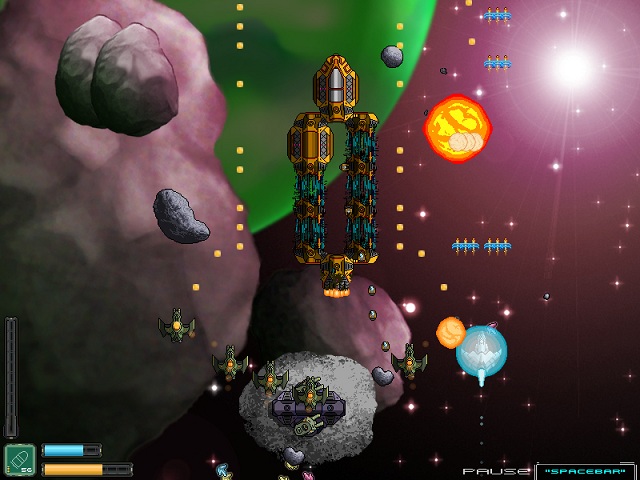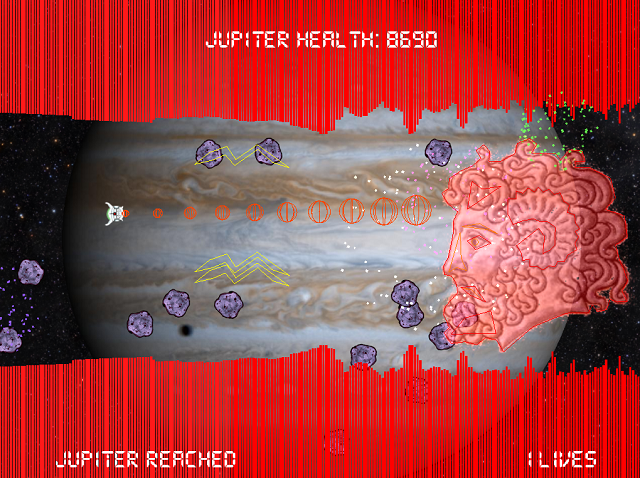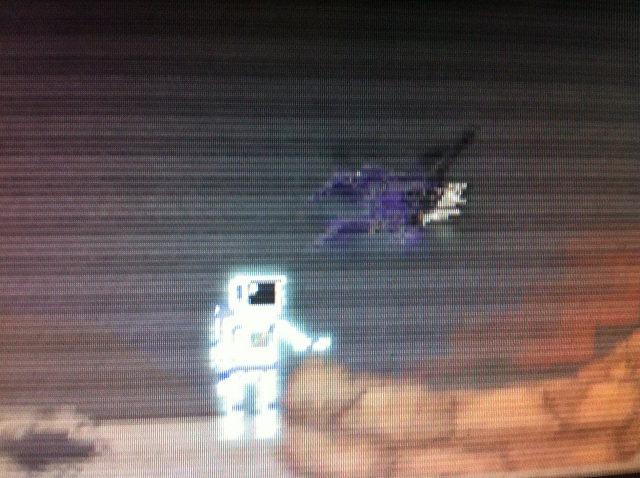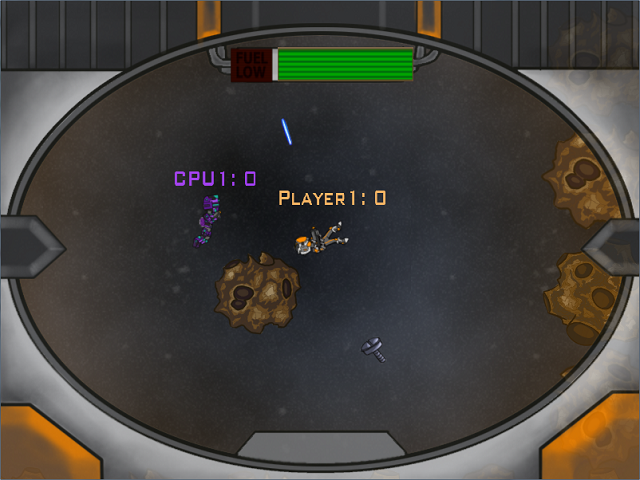The universe is innately captivating — even my son at the young age of 2-and-a-half marvels at the rocket ship decals, strung-up planets, and stars projected on his ceiling.
Last weekend, I visited Baltimore City’s long running and free Artscape festival that — you guessed it — showcases the passion of the area’s local, burgeoning creative community. This year, I saw the Gamescape exhibit, and within I witnessed a group of talented individuals likewise fascinated with galaxies, black holes, and exploding stars…and all the concepts they represent: the awe of discovery and the expanse of new, unexplored frontiers. In space, anything seems possible.
I walked through the double doors leading into the Bunting Center, a brick building on the Maryland Institute College of Art (MICA) campus. Just inside hustled a small group of local programmers, artists, and students who were setting up widescreen televisions, computers, and other equipment.
Pac-Man ghosts and Mega Man characters decorated the walls. An arcade room, sporting Mortal Kombat, Ikari Warriors III, and Bad Dudes vs. Dragon Ninja (among other games) and allowing just enough space for a half-dozen cabinets, lay hidden through an open archway. The cozy area provided for Gamescape had a “just thrown together” vibe; it lacked the bombastic marketing campaigns that characterize big video game conventions like Los Angeles’ Electronic Entertainment Expo.
I sat down to an inviting PlayStation 3 controller hooked up to a PC running the game Protostar by indie developer Bitty Bash. “Are you guys showing stuff yet?” I asked. I’d arrived early. Programmer Paolo Munoz responded enthusiastically, “Yes!” Protostar is a Galaga-type, top-down scrolling shooter set in outer space.
As I dodged enemy bullets and returned fire, Munoz explained to me that his kids had inspired him to make a game. At 7 and 4, they were just getting into titles like LittleBigPlanet and Mario Galaxy, and he wanted to create something they could all play together.
Using free tools from the Massachusetts Institute of Technology called Flash Develop, Munoz began building. “You can make a game, too,” with such things, he told me. Initially, his scope for Protostar was small, but that all changed when he brought in Scott Brown to create pixel graphics. Brown would come up with cool and interesting enemy designs, and Munoz then felt compelled to implement them into the game. With Jonathan Stuart rounding out the team as music composer and background artist, they completed a full-fledged title with a lengthy mission-based campaign.
Protostar is particularly traditional, but Munoz didn’t seem to mind. “You don’t have to be original to make something new,” he told me. “You’ll make something from the heart.” Heart was definitely on display, as I saw configurable ship systems (armor, shields, engines, blasters, launchers, and missiles) that function as a sort of self-directed, granular difficulty setting and missions that change when playing through a second time, keeping each experience fresh and encouraging multiple runs.
From this first 2D shooter, I made my way to the next, a game called Sinc by indie studio Seven Hills Games. Programmer and designer Greg Aring, who lives just outside the city in the Baltimore suburb of Catonsville, has taken the genre in a different direction by blending music with the standard gameplay and implementing the now common twin-stick shooter control scheme to the side-scroller.
Sinc is set in a post-Earth universe where you take control of the lone human left after an alien invasion of the planet. The twist is that all the world-destroying mayhem happened while you were away on a terraforming mission on Mars. The radio uplink back to Earth no longer transmits a reply. You can spend your time on the red surface looking at rocks, and if that sounds boring, it’s intentional. Aring even considered implementing a mode where you’d watch bacteria cultures grow…in real-time.
The meat of Sinc exists inside a hyper-sleep chamber where you spend most of your time. Since terraforming takes millions of years, it’s the only way to accomplish the job. But in there, your dreams will haunt you in the form of fast-paced shooter action.
Each dream is a journey to another distant planet in the Milky Way, and in your little space explorer, you’ll blast incoming enemies and eventually face a boss encounter. Aring told me that he considered making each level last the same amount of time that light would take to move between each location, but some stages became too long (Mars to Jupiter, for instance, would have been almost a half hour).
The game populates enemies onscreen based on the soundtrack playing in the background, and each trip features rows of digital decibel-level meters on the edges of the screen that shrink and grow with the music. The blend of sound and gameplay creates a captivating experience, and Aring has included a separate mode where you can just play the shooting portion of Sinc. There, you’ll collect “beats” that simultaneously change the pulsating soundtrack and create new challenges.
All of the music in Sinc comes courtesy of Zach Murphy and his band The Wet Dreams, which has a techno vibe that transcends into roaring cacophony as you approach the end of each stage. Boss encounters play to decidedly ominous undertones.
After that, I headed over to the MICA student projects, which featured two space-themed games built into retro-styled arcade cabinets. Midnight Astronaut, in a standup machine with a joystick and two buttons, caught my attention first with its dissonant ambiance and static video filter effect.
I took control of a space explorer on a 2D plane. Walking left or right soon revealed men with guns shuffling back and forth behind impassible sandbag enclosures. I could use one button to lift either of these men into the air as if by telekinesis, causing him to cry, “No! Put me down!” through an eerie walkie-talkie effect. The other input did nothing. A little odd…and intriguing. I wanted to know more, but unfortunately, the girl working the table had no idea what was going on.
She took me over to Discoursi, a game for two players with a joystick and two buttons for each. Players look down on a flat screen while facing one another, an act that creates a more intimate feel. That’s quite clever because the game appears to be about fostering a harmonious relationship.
Each player controls a separate ball of energy connected through a power beam. You need to stick close together while collecting other, floating concentrations of visible energy of differing colors in space. If you stretch too far apart, you split, and it’s game over.
My host and I weren’t particularly skilled at Discoursi, but we laughed every time one or both of us realized that we were watching the wrong energy ball, failing spectacularly at staying together. At this point, Midnight Astronaut’s screen changed, so I went back over to take another look.
Now my character was spinning in the cold vacuum of space while various objects floated by. Using my “telekinesis” hand, I could attract these things, and now the other button allowed me to eject them at high velocity in a direction of my choosing. Still wondering how this all fit together, my eye caught the University of Maryland, Baltimore County (UMBC) Game Developers Club sign over a row of monitors.
I’m a UMBC alum, so I was naturally curious. I sat down to Cosmoknights, a game that project lead Jonathan Moriarty conceived from his love of science fiction and the post-World War II space race between the U.S. and the Soviet Union.
I took control of an astronaut floating in the void looking for giant screws to fix his broken ship and fended off other players trying to rebuild their own crafts. I thought of this as a kind of blend between the premise of ToeJam and Earl and the gameplay of Asteroids.
Moriarty explained that Cosmoknights is “a simple multiplayer game that people can pick up and play without a lot of effort.” In the demo, I was only able to compete against computer A.I. characters, but the concept was clear enough.
These student projects from MICA and UMBC might not be ready for primetime, but they pushed forward unique concepts that embody the same space-exploring spirit I had already seen in the more polished works of Bitty Bash and Seven Hills.
Out of everything I saw at Gamescape, I left the festival this year thinking mostly of these games and their creators. Maybe it was the new directions or minor tweaks to existing formulas that hinted toward something unique. Maybe it was clever blends of form and function. Or maybe I’m just marveling at the possibilities.
VentureBeat's mission is to be a digital town square for technical decision-makers to gain knowledge about transformative enterprise technology and transact. Learn More
